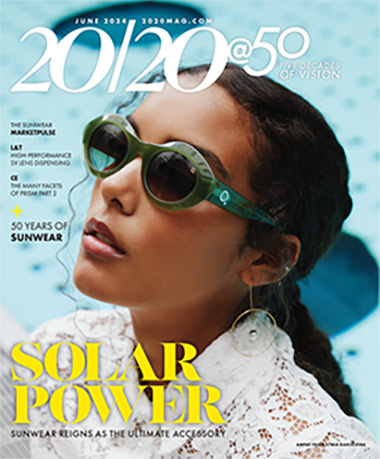
| |
Volume 6, Number 20
|
Monday, May 22, 2006
|

|
||
| Keratoconus and
Cellular Susceptibility to Stress-Related Challenges Investigators at the University of California Irvine Medical Center conducted a study to determine whether keratoconus (KC) corneal fibroblast cultures increase reactive oxygen species (ROS) production and are more susceptible to stress-related challenges. Nine normal and 10 KC stromal fibroblast cultures were incubated in either neutral- or low-pH conditions, with or without hydrogen peroxide. Researchers measured catalase activities with a fluorescent substrate assay and determined superoxide and ROS/reactive nitrogen species (RNS) productions with an amine-reactive green-dye assay and 2",7"-dichlorodihydrofluorescein diacetate (H2DCFDA) dye assay, respectively. They analyzed cell viability using a dye-exclusion assay and measured caspase 3 activity using a fluorochrome inhibitor of caspase (FLICA) assay. A cationic (green) dye was used to measure the mitochondrial membrane potential (m). KC fibroblasts increased superoxide and ROS/RNS production (6.2-fold and 1.8-fold, respectively) and catalase activity with higher concentrations of H2O2 compared with normal cultures. After a low-pH stress challenge, KC fibroblasts maintained higher ROS/RNS levels (3.3-fold), showed higher caspase-3 activity (7.5-fold) and decreased m (2.6-fold), and had decreased cell viability (37 percent vs. 20 percent) compared with normal fibroblasts. The authors believe that these properties may play a role in the pathogenesis of KC. |
|
SOURCE: Chwa M, Atilano SR, Reddy V, et al. Increased stress-induced generation of reactive oxygen species and apoptosis in human keratoconus fibroblasts. Invest Ophthalmol Vis Sci 2006;47(5):1902-10. |
|

|
||
| Topography of
the Central and Peripheral Cornea This Australian study investigated the topography of the central and peripheral cornea in a group of young adult subjects with a range of normal refractive errors. Researchers acquired corneal topography data for 100 young adult subjects using a method that allows central and peripheral maps to be combined to produce one large, extended corneal topography map. This computer-based method involves matching the common topographical features in the overlapping maps. The investigators analyzed corneal height, axial radius of curvature and axial power data; they also fit the corneal height data with Zernike polynomials. Conic fitting to the corneal height data revealed the average apical radius (Ro) was 7.77 +/- 0.2-mm and asphericity (Q) was -0.19 +/- 0.1 for a 6-mm corneal diameter. The conic fit parameters both changed significantly for increasing corneal diameters. For a 10-mm corneal diameter, Ro was 7.72 +/- 0.2 mm and Q was -0.36 +/- 0.1. A slight but significant meridional variation was found in Q, with the steepest principal corneal meridian flattening at a slightly greater rate than the flattest meridian. The RMS fit error for the conic section increased markedly for larger corneal diameters. Higher-order polynomial fits were needed to fit the peripheral corneal data adequately. Analysis of the axial power data revealed highly significant changes occurring in the corneal best-fit spherocylinder with increasing distance from the corneal center. The peripheral cornea became significantly flatter and decreased slightly in its toricity. Individual subjects exhibited a range of different patterns of central and peripheral corneal topography. Several of the higher-order corneal surface Zernike coefficients changed significantly with increasing corneal diameter. Based on these results, the investigators concluded that a conic section is a poor estimator of the peripheral cornea. |
|
SOURCE: Read SA, Collins MJ, Carney LG, Franklin RJ. The topography of the central and peripheral cornea. Invest Ophthalmol Vis Sci 2006;47(4):1404-15. |
|

|
||
| Corneal Thicknesses
and Endothelial Morphology in Diabetes In this study, Korean researchers evaluated the differences of corneal thickness and corneal endothelial morphology in diabetes compared with age-matched, healthy control subjects. Additionally, they tested for correlation according to the duration of diabetes. The researchers performed ultrasound pachymetry and noncontact specular microscopy on 200 patients with diabetes and 100 control subjects. They compared the values for diabetics and normal persons with analysis of covariance to adjust for age. They also examined the correlation between the subject parameters and the duration of diabetes using a partial correlation coefficient that controlled for age. Results showed that the diabetic subjects had thicker corneas, less cell density and hexagonality and more irregular cell size of the corneal endothelium than did the controls. Central corneal thickness and the coefficient of variation for cell size were significantly higher for diabetes of more than 10 years" duration than for diabetes of less than 10 years" duration. The endothelial cell density and percentage of hexagonal cells were lower for diabetes of more than 10 years" duration than for diabetes of less than 10 years" duration. Central corneal thickness was correlated with duration of diabetes, but corneal endothelial morphology was not. |
|
SOURCE: Lee JS, Oum BS, Choi HY, et al. Differences in corneal thickness and corneal endothelium related to duration in diabetes. Eye 2006;20(3):315-8. |
|

|
||
| Evaluation of
Wall Shear Stress on Retinal Microcirculation Wall shear stress (WSS) in retinal vessels can be evaluated noninvasively in humans using laser Doppler velocimetry (LDV) and cone-plate viscometry, according to Japanese investigators at Asahikawa Medical College. In the study, the researchers used LDV to measure retinal vessel diameter and mean centerline blood velocity (V[max, mean]) in the retinal arterioles and venules at first- and second-order branches in 13 subjects. They calculated retinal blood flow (RBF) and wall shear rate (WSR) using these two parameters. They also measured blood viscosity at the calculated shear rate using a cone-plate viscometer. WSS was calculated as the product of the WSR and the blood viscosity. In the first-order branches, the averaged diameter, V(max, mean), RBF and WSR (mean) were 108 +/- 13 microns, 41 +/- 10 mm/s, 11 +/- 4 microliters/min, and 1539 +/- 383 s(-1) in the arterioles and 147 +/- 13 microns, 23 +/- 3 mm/s, 12 +/- 4 microliters/min, and 632 +/- 73 s(-1) in the venules, respectively. The apparent blood viscosities at the measured shear rates were 3.5 +/- 0.3 centipoise (cP) in the arterioles and 3.8 +/- 0.4 cP in the venules. Therefore, the averaged WSS was 54 +/- 13 dyne/cm(2) in the arterioles and 24 +/- 4 dyne/cm(2) in the venules. The WSS in the second-order arterioles was significantly lower than that in the first-order branches, but the WSS in the first-order venules was similar to that in the second-order venules. The authors of this study believe that their system may be useful for further clinical investigation of the role of shear stress in the pathogenesis of various retinal disorders. |
|
SOURCE: Nagaoka T, Yoshida A. Noninvasive evaluation of wall shear stress on retinal microcirculation in humans. Invest Ophthalmol Vis Sci 2006;47(3):1113-9. |
|
BRIEFLY
|
|
|
||||||||||||||
| Subscriptions: Review of Ophthalmology Online
is provided free of charge as a service of Jobson Publishing, LLC. If
you enjoy reading Review of Ophthalmology Online, please tell a
friend or colleague about it. Forward this newsletter or send this address:
[email protected].
To change your subscription, reply to this message and give us your old
address and your new address; type "Change of Address" in the
subject line. If you do not want to receive Review of Ophthalmology
Online, reply to this message and type "Unsubscribe: Review of Ophthalmology
Online" in the subject line. Advertising: For information on advertising in this e-mail newsletter or other creative advertising opportunities with Review of Ophthalmology, please contact publisher Rick Bay, or sales managers James Henne, Michele Barrett or Kimberly McCarthy. News: To submit news, send an e-mail, or FAX your news to 610.492.1049 |














